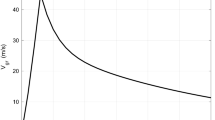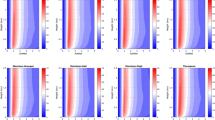Abstract
A three-dimensional numerical model is used to study boundary-layer eddy structure during a cold air outbreak. The model explicitly represents the large-scale three-dimensional motions, while small-scale turbulence is parameterized; it contains a water cycle with cloud formation and it takes into account infrared radiative cooling in cloudy conditions and the influence of large-scale vertical motions.
The model is applied to conditions corresponding to an observed case of cloud street/stratocumulus development which occurred over the Greenland Sea during the ARKTIS 1988 experiment. The boundary layer is found to grow rapidly as the cold air flows off the ice over the relatively warm water. Coherent structures were identified in this boundary layer. It is found that the rolls become increasingly more convective in character with distance from the ice edge. Qualitative and quantitative descriptions of the flow field are given. Additionally, the relative importance of the various physical processes and external parameters in the evolution of the mean field of variables is indicated.
Similar content being viewed by others
References
Betts, A. K.: 1973, ‘Non-Precipitating Cumulus Convection and its Parameterization’, Quart. J. Roy, Meteorol. Soc. 99 178–196.
Bougeault, Ph.: 1981, ‘Modeling the Trade Wind Cumulus Boundary Layer. Part I: Testing the Ensemble Cloud Relations against Numerical Data’, J. Atmos. Sci. 38 2414–2428.
Brown, R. A.: 1970, ‘A Secondary Flow Model for the Planetary Boundary Layer’, J. Atmos. Sci. 27 742–757.
Brown, R. A.: 1980, ‘Longitudinal Instabilities and Secondary Flows in the Planetary Boundary Layer: A Review’, Rev. Geophys. Space Phys. 18 683–697.
Brümmer, B.: 1985, ‘Structure, Dynamics and Energetics of Boundary Layer Rolls from KonTur Aircraft Observations’, Contr. Atm. Phys. 58 237–254.
Brummer, B., Rump, B., and Kruspe, G.: 1991, ‘A Cold Air Outbreak near Spitsbergen in Springtime: Boundary Layer Modification and Cloud Development ’, Boundary-Layer Meteorol. (in press).
Chlond, A.: 1987, ‘A Numerical Study of Horizontal Roll Vortices in Neutral and Unstable Atmospheric Boundary Layers’, Contr. Arm. Phys. 60 144–169.
Cox, S. K.: 1976, ‘Observation of Cloud Infrared Effective Emissitivity’, J. Atmos. Sci. 33 287–289.
Deardorff, J. W.: 1972, ‘Numerical Investigation of Neutral and Unstable Planetary Boundary Layers’, J. Atmos. Sci. 29 91–115.
Deardorff, J. W.: 1980, ‘Stratocumulus-Capped Mixed Layers Derived from a Three-Dimensional Model’, Boundary-Layer Meteorol. 18 495–527.
Etling, D., and Raasch, S.: 1987, ‘Numerical Simulation of Vortex Roll Development During a Cold Air Outbreak’, Dyn. Atmos. Oceans 10 277–290.
Hein, P. F., and Brown, R. A.: 1988, ‘Observations of Longitudinal Roll Vortices During Arctic Cold Air Outbreaks over Open Water’, Boundary-Layer Meteorol. 45 177–199.
Herring, J. R.: 1979, ‘Subgrid Scale Modeling — An Introduction and Overview’, Turb. Shear Flows 1 347–352.
Kahn, P. H., and Businger, J. A.: 1979, ‘The Effect of Radiative Flux Divergence on Entrainment of a Saturated Convective Boundary Layer’, Quart. J. Roy. Meteorol Soc. 105 303–305.
Küttner, J. P.: 1971, ‘Cloud Bands in the Atmosphere’, Tellus 23 404–425.
LeMone, M. A.: 1973, ‘The Structure and Dynamics of Horizontal Roll Vortices in the Planetary Boundary Layer’, J. Atmos. Sci. 30 1077–1091.
LeMone, M. A.: 1976, ‘Modulation of Turbulence Energy of Longitudinal Rolls in an Unstable Planetary Boundary Layer’, J. Atmos. Sci. 33 1308–1320.
Lewellen, W. S.: 1977, ‘Use of Invariant Modeling. Handbook of Turbulence’, Plenum 237–290.
Mason, P. J., and Sykes, R. I.: 1982, ‘A Two-Dimensional Numerical Study of Horizontal Roll Vortice in an Inversion Capped Planetary Boundary Layer’, Quart. J. Roy. Meteorol. Soc. 108 801–823.
Mason, P. J.: 1985, ‘A Numerical Study of Cloud Streets in the Planetary Boundary Layer’, Boundary-Layer Meterol. Soc. 2 281–304.
Mason, P. J.: 1989, ‘Large Eddy Simulation of the Convective Atmospheric Boundary Layer’, J. Atmos. Sci. 46 1492–1516.
Mellor, G. L., and Yamada, T.: 1974, ‘A Hierarchy of Turbulence Closure Models for Planetary Boundary Layers’, J. Atmos. Sci. 31 1791–1806.
Miura, Y.: 1986, ‘Aspect Ratios of Longitudinal Rolls and Convection Cells Observed During Cold Air Outbreaks’, J. Atmos. Sci. 43 26–39.
Piasek, S. A., and Williams, G. P.: 1970, ‘Conservation Properties of Convection Difference Schemes’, J. Comput. Phys. 6 392–405.
Raasch, S.: 1990, ‘Numerical Simulation of the Development of the Convective Boundary Layer During a Cold Air Outbreak’, Boundary-Layer Meteorol. Soc. 52 349–375.
Schumann, U., and Friedrich, R. (Eds.): 1986, ‘Direct and Large Eddy Simulation of Turbulence’, Notes on Numer. Fluid Mech., Vol. 15, Vieweg, Braunschweig.
Sommeria, G.: 1976, ‘Three-Dimensional Simulation of Turbulent Processes in an Undisturbed Trade Wind Boundary Layer’, J. Atmos. Sci. 33 216–241.
Sommeria, G., and Deardorff, J. W.: 1977, ‘Subgrid-Scale Condensation in Models of Nonprecipitating Clouds’, J. Atmos. Sci. 34 344–355.
Stephens, G. L.: 1978, ‘Radiation Profiles in Extended Water Clouds. Part II: Parameterization Schemes’, J. Atmos. Sci. 35 2123–2132.
Sykes, R. I., Lewellen, W. S., and Henn, D. S.: 1988, ‘A Numerical Study of the Development of Cloud Street Spacing’, J. Atmos. Sci. 45 2556–2569.
Sykes, R. I., Lewellen, W. S., and Henn, D. S.: 1990, ‘Numerical Simulation of the Boundary-Layer Eddy Structure During the Cold-Air Outbreak of GALE IOP2’, Mon. Wea. Rev. 118 363–374.
Walter, B. A.: 1980, ‘Wintertime Observations of Roll Clouds over the Bering Sea’, Mon. Wea. Rev. 108 2024–2031.
Webb, E. K.: 1982, ‘Profile Relationships in the Superadiabatic Surface Layer’, Quart. J. Roy. Meteorol. Soc. 108 661–688.
Williams, G. P.: 1969, ‘Numerical Integration of the Three-Dimensional Navier-Stokes Equations for Incompressible Flow’, J. Fluid Mech. 37 727–750.
Author information
Authors and Affiliations
Rights and permissions
About this article
Cite this article
Chlond, A. Three-dimensional simulation of cloud street development during a cold air outbreak. Boundary-Layer Meteorol 58, 161–200 (1992). https://doi.org/10.1007/BF00120757
Accepted:
Issue Date:
DOI: https://doi.org/10.1007/BF00120757




